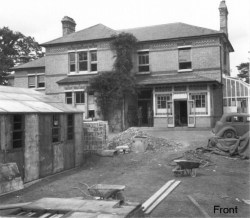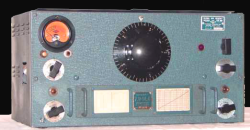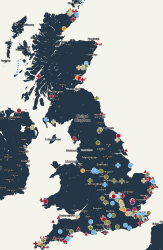I often ask people: What’s the most important thing you need to have a successful fishing trip? I get a lot of different answers about bait, equipment, and boats. Some people tell me beer. But the best answer, in my opinion, is fish. Without fish, you are sure to come home empty-handed.
On a recent visit to Bletchley Park, I thought about this and how it relates to World War II codebreaking. All the computers and smart people in the world won’t help you decode messages if you don’t already have the messages. So while Alan Turing and the codebreakers at Bletchley are well-known, at least in our circles, fewer people know about Arkley View.
The problem was apparent to the British. The Axis powers were sending lots of radio traffic. It would take a literal army of radio operators to record it all. Colonel Adrian Simpson sent a report to the director of MI5 in 1938 explaining that the three listening stations were not enough. The proposal was to build a network of volunteers to handle radio traffic interception.
That was the start of the Radio Security Service (RSS), which started operating out of some unused cells at a prison in London. The volunteers? Experienced ham radio operators who used their own equipment, at first, with the particular goal of intercepting transmissions from enemy agents on home soil.
At the start of the war, ham operators had their transmitters impounded. However, they still had their receivers and, of course, could all read Morse code. Further, they were probably accustomed to pulling out Morse code messages under challenging radio conditions.
Over time, this volunteer army of hams would swell to about 1,500 members. The RSS also supplied some radio gear to help in the task. MI5 checked each potential member, and the local police would visit to ensure the applicant was trustworthy. Keep in mind that radio intercepts were also done by servicemen and women (especially women) although many of them were engaged in reporting on voice communication or military communications.
Early Days
The VIs (voluntary interceptors) were asked to record any station they couldn’t identify and submit a log that included the messages to the RSS.

Thanks to a double agent, the RSS was able to decode the messages that were between agents in Europe and their Abwehr handlers back in Germany (the Abwehr was the German Secret Service) as well as Abwehr offices in foreign cities. Later messages contained Enigma-coded groups, as well.
Between the RSS team’s growth and the fear of bombing, the prison was traded for Arkley View, a large house near Barnet, north of London. Encoded messages went to Bletchley and, from there, to others up to Churchill. Soon, the RSS had orders to concentrate on the Abwehr and their SS rivals, the Sicherheitsdienst.
Change in Management
In 1941, MI6 decided that since the RSS was dealing with foreign radio traffic, they should be in charge, and thus RSS became SCU3 (Special Communications Unit 3).
There was fear that some operators might be taken away for normal military service, so some operators were inducted into the Army — sort of. They were put in uniform as part of the Royal Corps of Signals, but not required to do very much you’d expect from an Army recruit.
Those who worked at Arkley View would process logs from VIs and other radio operators to classify them and correlate them in cases where there were multiple logs. One operator might miss a few characters that could be found in a different log, for example.
Going 24/7

Many of the direction finding operators came from VIs. The stations typically had four antennas in a directional array. When one of the central stations (the Y stations) picked up a signal, they would call direction finding stations using dedicated phone lines and send them the signal.

The operator would hear the phone signal in one ear and the radio signal in the other. Then, they would change the antenna pattern electrically until the signal went quiet, indicating the antenna was electrically pointing away from the signals.
The DF operator would hear this signal in one earpiece. They would then tune their radio receiver to the right frequency and match the signal from the main station in one ear to the signal from their receiver in the other ear. This made sure they were measuring the correct signal among the various other noise and interference. The DF operator would then take a bearing by rotating the dial on their radiogoniometer until the signal faded out. That indicated the antenna was pointing the wrong way which means you could deduce which way it should be pointing.
The central station could plot lines from three direction finding stations and tell the source of a transmission. Sort of. It wasn’t incredibly accurate, but it did help differentiate signals from different transmitters. Later, other types of direction-finding gear saw service, but the idea was still the same.
Interesting VIs
Most of the VIs, like most hams at the time, were men. But there were a few women, including Helena Crawley. She was encouraged to marry her husband Leslie, another VI, so they could be relocated to Orkney to copy radio traffic from Norway.
In 1941, a single VI was able to record an important message of 4,429 characters. He was bedridden from a landmine injury during the Great War. He operated from bed using mirrors and special control extensions. For his work, he receive the British Empire Medal and a personal letter of gratitude from Churchill.
Results
Because of the intercepts of the German spy agency’s communications, many potential German agents were known before they arrived in the UK. Of about 120 agents arriving, almost 30 were turned into double agents. Others were arrested and, possibly, executed.
By the end of the war, the RSS had decoded around a quarter of a million intercepts. It was very smart of MI5 to realize that it could leverage a large number of trained radio operators both to cover the country with receivers and to free up military stations for other uses.
Meanwhile, on the other side of the Atlantic, the FCC had a similar plan.
The BBC did a documentary about the work the hams did during the war. You can watch it below.
















You can always stop at local supermarket and buy a fish, then you come at home satisfied.
Ron Swanson has an opinion on buying things :)
Ron Swanson sucks
He’s supposed to. He is an archetype of both the best and absolute worst aspects of this sort of person and that’s why people like him as a character. A good reference to him is a bombastic criticism with a degree of separation like the one above.
It has been said that a bad day fishing is better than a good a day at the office.
And it can be true because you wanted to go fishing.
I’ve never regarded fish as being the best outcome of a fishing trip, I’ve often “gone fishing” with a cool bag of food, a flask of coffee and no bait because, for me, the aim is relaxation and just watching the sea, occasionally casting a few ounces of weight into the sea is pretty much exactly what switches my mind off.
Interesting article though, there’s an awful lot of equipment out there which could be put to good use, and the UK licence at least still includes clauses which mean you and your station could be requested to cooperate with duly authorised people.
We go fishing, well, we call dragging our lines and drinking all day, ‘fishing’, and the aim is not to come home with fish, but just get good people together for extended periods, which in my opinion allows their real personalities to come to the surface.
Heh – I was visiting Bletchley Park just a week ago! Awesome place. You really need two days – one for BP itself, the other for the Computer History Museum. They have a working Witch, a working Colossus (it reads the punch strips optically!), a working EDSAC, some working ICL Big Iron and of course lots of home computers, some of which are very rare.
I can recommend “Listening to the Enemy” by Michael Griffiths which details the work of VIs (later full RSS operators) at the St.Erth RSS site, many of whom also served at Arkley & SCU3.
My great grandfather was trained by British signals corpsmen before being sent into North Africa, and later Italy and on into Germany. He was a Boy Scout before the war and had two very prized possessions at the time, he could speak fluent German with a Hannover accent and knew Morse Code and how to operate a HAM radio.
He trained in Signals Intellegence in Texas before going to England. During deployment he was often sent behind enemy lines to intercept or tap into enemy communications lines (he was also trained as a lineman in Texas). He worked with the OSS (precursor to the CIA) as well as the British.
After the war ended in Europe, his younger brother stayed on as a translator for IBM to help with their new “real time translation” service being provided at the Hague. He is in the background of some of the archival footage of it online in YouTube.
His official duty station was Supply Sargeant, which allowed him to access needed materials for completing missions without having to always go through intermediaries.
We have an archive of old photos of him, 6’4″ green eyed blonde dude in fatigues that looked like he only needed to take two steps up to reach the top of a telephone pole (weighed well under 150lbs throughout the war and after) that could pass as a poster boy for Nazi propaganda posters.
He enjoyed his time in service in no small part because he hated how his cousins back in Germany had made things so bad, that he was forced to go fight them. He never went back to Germany or spoke a word of Deutch after his time was over. He did go on to tech future gens about radio communication though, myself included which helped foster in me a definite passion for computers and electronics.
A passion that I passed on which has lead to my youngest niece talking to both Santa Claus and the ISS from a tiny little shack just west of Seattle.
Funny old world. 😎
Great post.
Gone fishin.
“they built a number of Y stations with two National HRO receivers from America at each listening position. ”
The reason why two sets were supplied.
My Dad was in the Royal Signals during the war, following the 8th Army through North Africa, into Sicily and up Italy.
From what I remember of what he told me, he had a pair of HROs or sometimes Hallicrafters and split headphones. One set was tuned to a network frequency, while the other was used to tune around as a search receiver while he waited for any net traffic to intercept. If he found an interesting signal on the search receiver, the officer in charge would tune a Bendix frequency meter to heterodyne the signal, in order to record the frequency.
He told me that some nets were extremely terse, and you might get a single ‘dit’ meaning ‘do you have traffic’, followed by a responding ‘dit’ meaning ‘no’, and that might be the only traffic for the day on that frequency.
All communications he handled were in five figure coded Morse groups. He once told me that he believed somebody was able to make sense of them somewhere, but he could not be sure.
Ironically he and I once spent a night in the accommodation at Bletchley Park, the venue for a First Aid competition, some years before its wartime role was disclosed.
“MI5 checked each potential member”
And the Cambridge Five give MI5 a HeeHaw “Saaaalooooot!”
As Roger Hollis laughs in his grave.
Buncha Brit poofs. I mean poobahs.
Great article! Thanks very much! My grandfather was a trainer of radio operators in the Canadian army during the war. I have some memories of him sitting at his radio station in the basement when I was child and I still have his code key.
Great article, and lovely personal historical anecdotes from @IanS, @MJ, and @Gord. Thanks, @James for mention of doc to watch.
The sequential paragraphs starting with “The operator” and “The DF operator” appear to be redundant versions of the same paragraph.